در مورد معماری کلاسیک رم و ایتالیا به متن زیر توجه کنید:
Main sights
See also: List of tourist attractions in Rome and List of streets in Rome
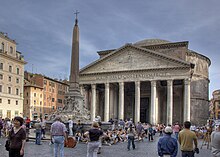
The Pantheon

The Quirinal Palace.
[edit] Architecture
Main article: Architecture of Rome
[edit] Ancient Rome
Main articles: List of ancient monuments in Rome and Ancient Roman architecture
One of the symbols of Rome is the Colosseum (70–80 AD), the largest amphitheatre ever built in the Roman Empire. Originally capable of seating 60,000 spectators, it was used for gladiatorial combat. A list of important monuments and sites of ancient Rome includes the Roman Forum, the Domus Aurea, the Pantheon, Trajan's Column, Trajan's Market, the Catacombs, the Circus Maximus, the Baths of Caracalla, Castel Sant'Angelo, the Mausoleum of Augustus, the Ara Pacis, the Arch of Constantine, the Pyramid of Cestius, and the Bocca della Verità.[edit] Medieval
Often overlooked, Rome's medieval heritage is one of the largest in Italian cities. Basilicas dating from the Paleochristian age include Santa Maria Maggiore and San Paolo Fuori le Mura (the latter largely rebuilt in the 19th century), both housing precious 4th century AD mosaics. Later notable medieval mosaic and fresco art can be also found in the churches of Santa Maria in Trastevere, Santi Quattro Coronati, and Santa Prassede. Lay buildings include a number of towers, the largest being the Torre delle Milizie and the Torre dei Conti, both next the Roman Forum, and the huge staircase leading to the basilica of Santa Maria in Ara Coeli.[edit] Renaissance and Baroque
Rome was a major world centre of the Renaissance, second only to Florence, and was profoundly affected by the movement. Among others, a masterpiece of Renaissance architecture in Rome is the Piazza del Campidoglio by Michelangelo. During this period, the great aristocratic families of Rome used to build opulent dwellings as the Palazzo del Quirinale (now seat of the President of the Italian Republic), the Palazzo Venezia, the Palazzo Farnese, the Palazzo Barberini, the Palazzo Chigi (now seat of the Italian Prime Minister), the Palazzo Spada, the Palazzo della Cancelleria, and the Villa Farnesina.Many of the famous city's squares - some huge, majestic and often adorned with obelisks, some small and pictoresque - got their present shape during the Renaissance and Baroque. The principal ones are Piazza Navona, Piazza di Spagna, Campo de' Fiori, Piazza Venezia, Piazza Farnese, Piazza della Rotonda and Piazza della Minerva. One of the most emblematic examples of Baroque art is the Fontana di Trevi by Nicola Salvi. Other notable 17th-century baroque palaces are the Palazzo Madama, now the seat of the Italian Senate and the Palazzo Montecitorio, now the seat of the Chamber of Deputies of Italy.
[edit] Neoclassicism

The neoclassical Piazza del Popolo.
[edit] Fascist architecture
See also: Fascist architecture
The Fascist regime that ruled in Italy between 1922 and 1943 developed an architectural style that was characterised by its links with ancient Roman architecture. The most important Fascist site in Rome is the E.U.R district, designed in 1938 by Marcello Piacentini. It was originally conceived for the 1942 world exhibition, and was called "E.42" ("Esposizione 42"). The world exhibition, however, never took place because Italy entered the Second World War in 1940. The most representative building of the Fascist style at E.U.R. is the Palazzo della Civiltà Italiana (1938–1943), the iconic design of which has been labelled the cubic or Square Colosseum. After World War II, the Roman authorities found that they already had the seed of an off-centre business district of the type that other capitals were still planning (London Docklands and La Défense in Paris). Also the Palazzo della Farnesina, the current seat of Italian Foreign Ministry, was designed in 1935 in Fascist style.[edit] Parks and gardens
Main article: List of parks and gardens in Rome
Public parks and nature reserves cover a large area in Rome, and the city has one of the largest areas of green space amongst European capitals.[47] The most notable part of this green space is represented by the large number of villas and landscaped gardens created by the Italian aristocracy. While many villas were destroyed during the building boom of the late 19th century, a great many remain. The most notable of these are Villa Borghese, Villa Ada, and Villa Doria Pamphili. Villa Doria Pamphili is west of the Gianicolo hill comprising some 1.8 km2. Also on the Gianicolo hill there is Villa Sciarra, with playgrounds for children and shaded walking areas. In the nearby area of Trastevere the Orto Botanico (Botanical Garden) is a cool and shady green space. The old Roman hippodrome (Circus Maximus) is another large green space but the main attraction is the ancient site of the chariot racing and it has few trees. Nearby is the lush Villa Celimontana, close to the gardens surrounding the Baths of Caracalla and Rose Garden (‘roseto comunale’). The Villa Borghese garden is the best known large green space in Rome, with famous art galleries among its shaded walks. It is close to the Spanish Steps and Piazza del Popolo. Rome also has a number of regional parks of much more recent origin including the Pineto Regional Park and the Appian Way Regional Park. There are also nature reserves at Marcigliana and at Tenuta di Castelporziano.[edit] Fountains and aqueducts
Main articles: List of fountains in Rome and List of aqueducts in the city of Rome

The Trevi Fountain
[edit] Statues
Main article: Talking statues of Rome
[edit] Obelisks and columns
Main article: List of obelisks in Rome
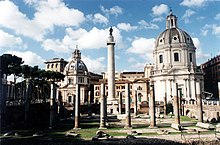
The column of Trajan, or in Italian "Colonna Traiana", an ancient Roman column in the city.
[edit] Bridges
Main article: List of bridges in Rome
The city of Rome contains numerous famous bridges which cross the Tiber. Famous ones include the Ponte Cestio, the Ponte Milvio, the Ponte Nomentano, the Ponte Sant'Angelo, the Ponte Vittorio Emanuele II, the Ponte Sisto and the Ponte dei Quattro Capi. Currently there are five ancient Roman bridges still remaining in the city.[51] Most of the city's public bridges were built in Classical or Renaissance style, but also in Baroque, Neoclassical and Modern styles. According to the Encyclopædia Britannica, the finest ancient bridge remaining in Rome is the Ponte Sant'Angelo, which was completed in 135AD, and was decorated with 10 statues of the angels, designed by Bernini in 1688.[52][edit] Catacombs
Main article: Catacombs of Rome
Rome has extensive amount of ancient catacombs, or underground burial places under or near the city, of which there are at least forty, some discovered only in recent decades. Though most famous for Christian burials, they include pagan and Jewish burials, either in separate catacombs or mixed together. The first large-scale catacombs were excavated from the 2nd century onwards. Originally they were carved through tuff, a soft volcanic rock, outside the boundaries of the city, because Roman law forbade burial places within city limits. Currently maintenance of the catacombs is in the hands of the Papacy which has invested in the Salesians of Don Bosco the supervision of the Catacombs of St. Callixtus on the outskirts of Rome.[edit] Economy
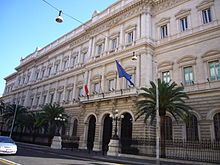
The Banca d'Italia (Bank of Italy) in Via Nazionale, Rome.
Main article: Economy of Rome
With a 2005 GDP of €94.376 billion (US$121.5 billion),[53] the city produces 6.7% of the national GDP (more than any other single city in Italy), and its unemployment rate, lowered from 11.1% to 6.5% between 2001 and 2005, is now one of the lowest rates of all the European Union capital cities.[53] Rome grows +4.4% annually and continues to grow at a higher rate in comparison to any other city in the rest of the country.[53] This means that were Rome a country, it would be the world's 52nd richest country by GDP, near to the size to that of Egypt. Rome also had a 2003 GDP per capita of €29,153 (US$ 37,412), which was second in Italy, (after Milan), and is more than 134.1% of the EU average GDP per capita.[54] Rome, on the whole, has the highest total earnings in Italy, reaching €47,076,890,463 in 2008,[55] yet, in terms of average workers' incomes, the city places itself 9th in Italy, with €24,509, coming after Treviso (€24,593) and Siena (€24,549), and surpassing Parma (€24,456) and Varese (€24,045).[55] On a global level, Rome's workers receive the 30th highest wages in 2009, coming three places higher than in 2008, in which the city was 33rd. This means that, whilst gross average earnings are less than Madrid and Barcelona, they are more than some other cities, such as Athens, Lisbon, Dubai and Hong Kong.[56]Although the economy of Rome is characterised by the absence of heavy industry and it is largely dominated by services, high-technology companies (IT, aerospace, defence, telecommunications), research, construction and commercial activities (especially banking), and the huge development of tourism are very dynamic and extremely important to its economy. Rome's international airport, Fiumicino, is the largest in Italy, and the city hosts the head offices of the vast majority of the major Italian companies, as well as the headquarters of three of the world's 100 largest companies: Enel, Eni, and Telecom Italia.[57]
Universities, national radio and television and the movie industry in Rome are also important parts of the economy: Rome is also the hub of the Italian film industry, thanks to the Cinecittà studios, working since the 1930s. The city is also a centre for banking and insurance as well as electronics, energy, transport, and aerospace industries. Numerous international companies and agencies headquarters, government ministries, conference centres, sports venues, and museums are located in Rome's principal business districts: the Esposizione Universale Roma (EUR); the Torrino (further south from the EUR); the Magliana; the Parco de' Medici-Laurentina and the so-called Tiburtina-valley along the ancient Via Tiburtina.




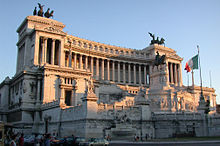








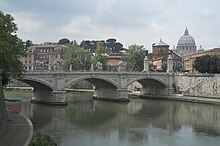

No comments:
Post a Comment